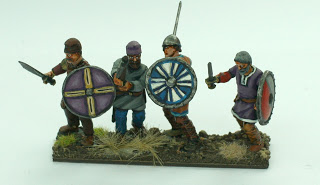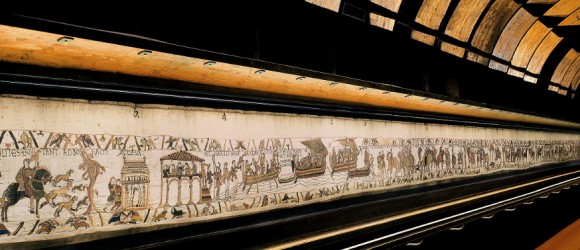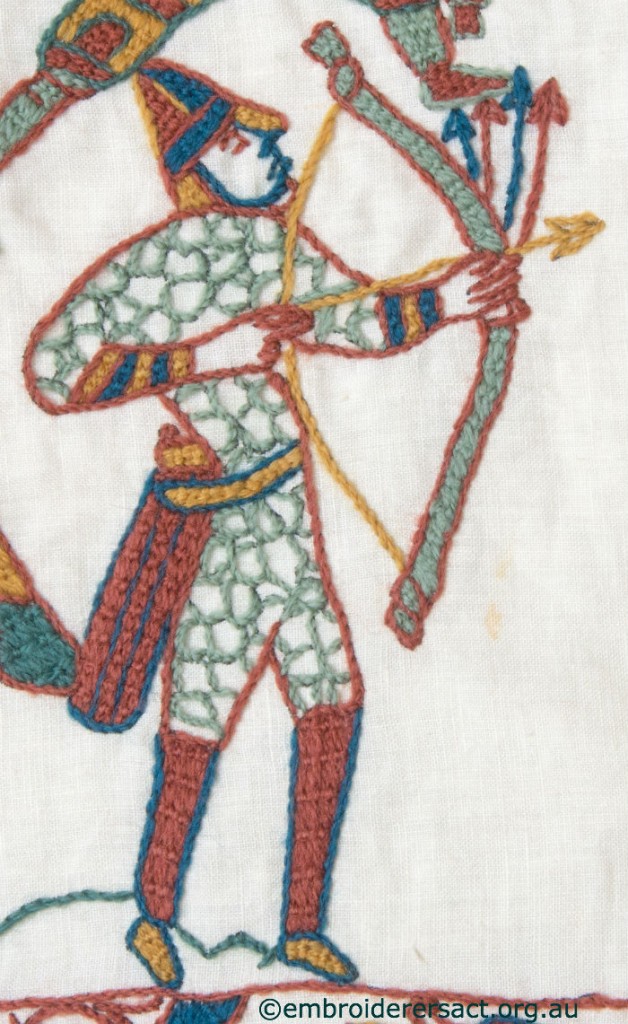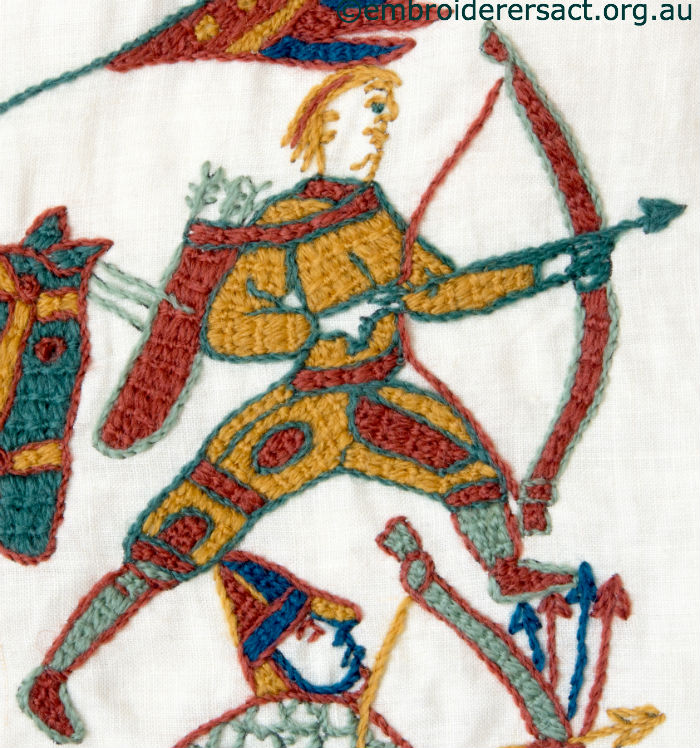This is the story of how one of our members Gail Haidon came to stitch a panel of the Bayeux Tapestry.
I am married to a wargamer who has an abiding love of history and particularly military history. This has led to a large and constantly expanding library of history books together with board games and hundreds if not thousands of small model figures.


We have long cultivated a “live and let live” attitude to one another’s interests. After all I have UFO’s (Unfinished Objects), and he has UFA’s (Unfinished Armies)! Neither of us ever confesses just how many we have.
Many years ago, Ian obtained a copy of a book The Bayeux Tapestry: the complete tapestry in colour with introduction description and commentary by David M Wilson.
What was I thinking??
In an inexplicably weak moment I offered to embroider a replica of any part of the Tapestry he wanted thinking that I would have it ready for his 40th birthday.
Time wore on; I was going to have to (1) copy or trace a part of the Tapestry from the book, (2) decide whether to enlarge (the book shows the panels less than full scale), (3) source the linen, (4) select and source the correct weight and colour of the wool, (5) develop a legend of what stitches to use, with how and where to use them, and (6) get on with it!
I thought about it a bit but nothing happened.
Visiting Bayeux
Some time later we travelled overseas for almost three months and particularly in the UK, France and Belgium saw many battlefields and military museums such as:
Bosworth Field – site of the last significant battle of the Wars of the Roses
Culloden Moor – site of the final confrontation of the 1745 Jacobite Rising
Hastings/Battle – 1066 Battle of Hastings, Abbey and Battlefield site
The Somme, with the beautiful and sad countryside of the battlefields of the Western Front of World War 1, and where my great-uncle lies somewhere in an unknown grave
Bayeux – site of the Musée de la Tapisserie de Bayeux

And many many others!
However, prior to that “big overseas trip” and knowing that a certain person was planning to see certain things I put my foot down and demanded that if I was going to be “dragged around half the battlefields of Europe” I was at least going to get to see the Bayeux Tapestry!
Bayeux Tapestry
Bayeux is an extremely pretty town in Normandy (northwestern France), and the tapestry (actually an embroidery) is beautifully displayed in its own museum. There is a darkened, curved corridor with the Tapestry displayed at eye level in a way that people can get a really close look.

It was amusing to see the number of people with faces squashed up against the glass, closely examining the stitching – surely some of them must have been embroiderers! I felt sorry for the cleaners – there must be constant cleaning of finger, and nose(!) prints. It can clearly be seen where areas of damage have been repaired and where different stitchers must have worked with looser and tighter stitching in different sections.
The Tapestry now is about 70 metres long with about fifty scenes embroidered on linen with coloured woollen yarns. It is believed that it was commissioned by Bishop Odo (who was Bishop of Bayeux, and William the Conqueror’s half brother) for the Bayeux Cathedral, and probably made in a monastery in the south of England, not Bayeux, in the 1070’s.
In its almost 1,000 years of history it has miraculously survived having been rescued from being cut up for military wagon covers during the French Revolution and being confiscated for propaganda purposes prior to Napoleon’s planned invasion of Britain. The Bayeux Council later displayed it damaging it in the process. It is believed that at least two panels of the tapestry are missing at the end – up to another 6.4 metres. This missing area would probably have included William’s coronation and reign.
So how did I come to do my panel? Well of course the last stop on leaving the museum is to go through the shop! And lo and behold there were 1:1 scale kits with pre-printed linen, and coloured wools ready to go.

Stitching my Panel
So eventually it was back to Australia where I enthusiastically began. I remember timing the first section I completed and estimating that there were about 240 hours of work to finish the entire kit.
So time went by and as most embroiderers will know it grew in fits and starts spending periods in the cupboard with the other UFO’s.
The pre-printed outlines must have been transferred from a photograph that included some creases so I had to embroider over some lines that do not exist on the original. I eventually used a quilting frame rather than embroidery hoop to more conveniently hold the fabric. Ian’s book was invaluable in showing the exact stitching as sometimes the instructions in the kit left a bit to be desired.
Bayeux Stitch
I learned a new stitch, “Bayeux stitch”, a laid and couched stitch which is an Anglo-Saxon variation of an ancient technique known as laidwork. Although this is great for securely covering large areas I have sworn that I will never embroider another horse’s backside as long as I live!
Here’s what the stitch looks like:



The UK Embroiderers’ Guild has a useful guide to Bayeux Stitch which you can find here.
Ian’s 40th birthday came and went and if he occasionally felt like complaining I would offer to teach him how to embroider! I started to joke that if he was lucky he might receive it for his 90th birthday! He actually received it in time for his 50th so I think it “only” took about 12 years from start to finish.
Military History of this Panel
And the reasons for selecting this particular panel? Ian tells me that it documents a change in military tactics for cavalry in the early medieval period – from using spears overarm to underarm. The cavalry using their spears overarm are Bretons:

and those underarm are Normans:

The Norman infantryman leading the panel is unique and very special because he’s the only archer on the entire Bayeux Tapestry wearing chain mail. For this reason it’s believed that he may actually be a crossbowman.

Crossbows were very new technology at the time and those designing the Tapestry might not have known what they looked like. Although he’s not depicted with a crossbow scholars have noted that his arrow quiver is shown being carried on his hip as a crossbowman would have done.
The other archer is also shown with a bow but he’s carrying his arrows on his back – the standard protocol of the time:

So there you are a famous historical embroidery complete with mysteries and differences of opinion about it and a number of replicas around the world. Surely an excuse for another trip or two?
Gail




